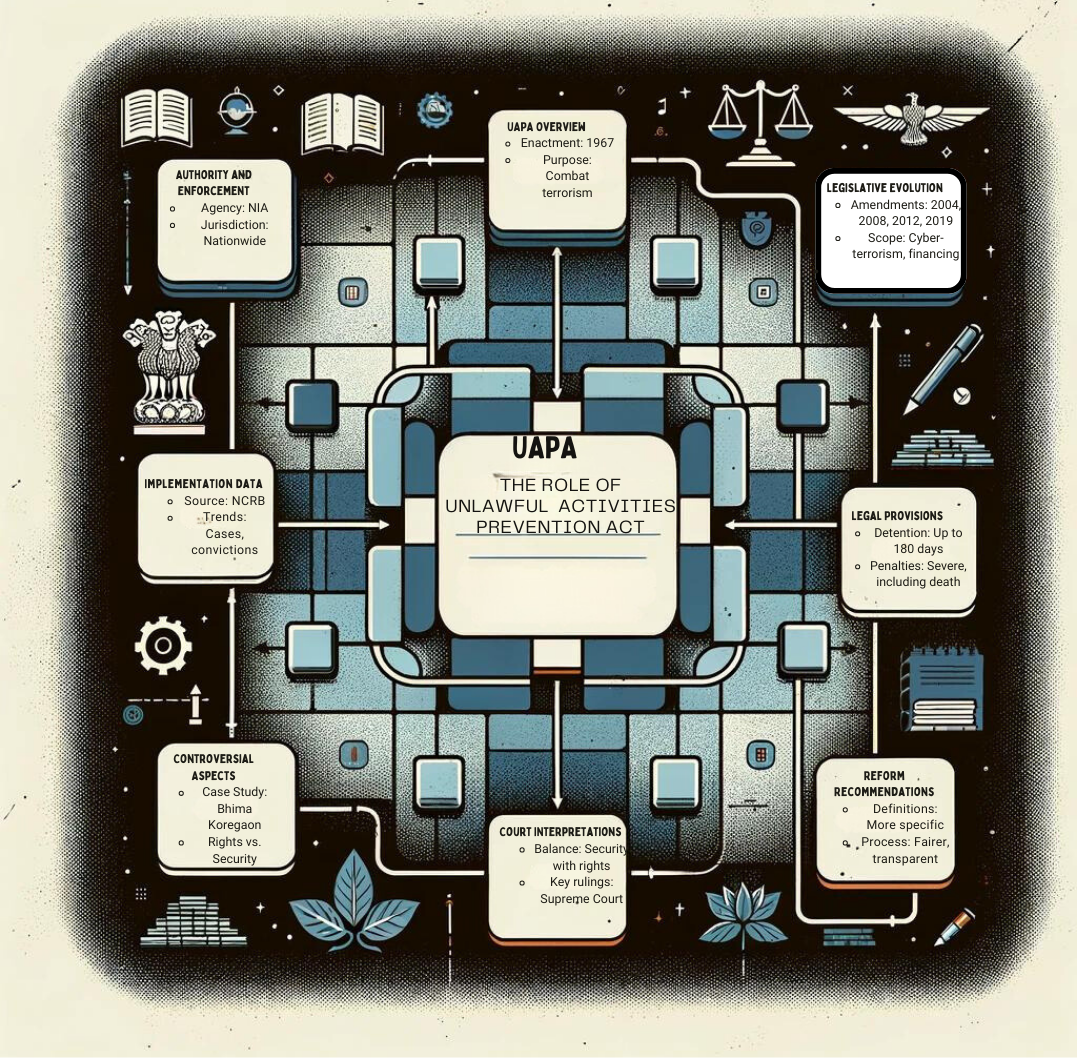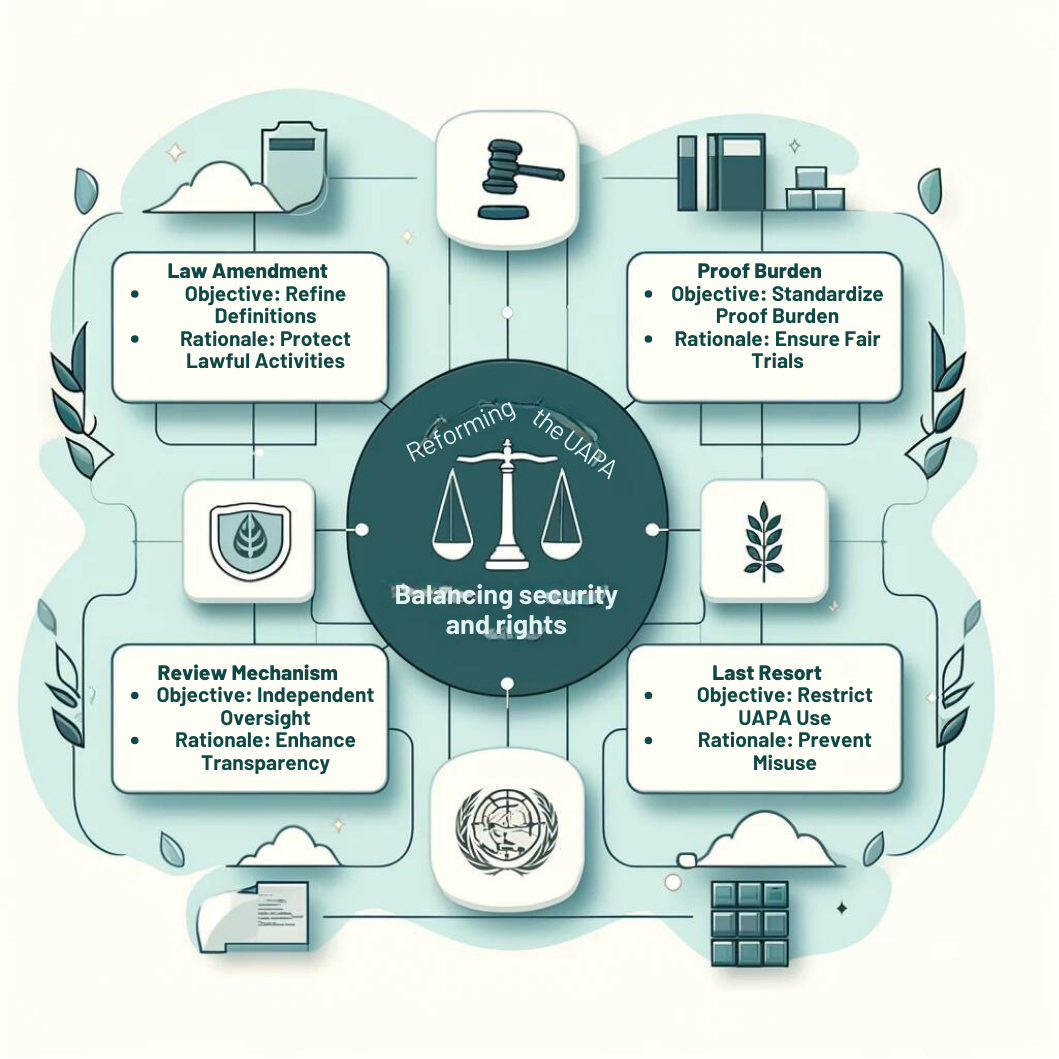
The Unlawful Activities Prevention Act (UAPA), enacted in 1967, stands as one of India’s most stringent laws aimed at combating terrorism and safeguarding national security. Designed to address threats from secessionist movements and anti-national activities, the Act has evolved through several amendments to enhance its efficacy against modern-day challenges like cyber-terrorism and the financing of terrorism. However, its application has sparked significant debate regarding the balance between ensuring security and preserving individual rights. This detailed analysis explores the UAPA’s provisions, its implications, the debates it has ignited, and potential pathways for reform.
Overview of the Unlawful Activities Prevention Act (UAPA)
What is Unlawful Activities Prevention Act (UAPA)?
1. Enactment and Amendments
- Initial Enactment (1967): The UAPA was originally enacted to address secessionist movements and anti-national activities that threatened the integrity and sovereignty of India.
- Subsequent Amendments: The Act has been amended multiple times, with significant amendments in 2004, 2008, 2012, and the most recent in 2019. These amendments have expanded the scope of the law to include modern forms of terrorism such as cyber-terrorism, the financing of terrorism, and the designation of individuals as terrorists.
2. Empowerment of National Investigation Agency (NIA)
- The UAPA grants significant powers to the National Investigation Agency (NIA), allowing it to investigate and prosecute cases under the Act across the entire country. This centralizes the approach to combating terrorism and ensures a unified legal procedure for dealing with such threats.
3. Provisions for Detention and Punishment
- Detention Without Charge: The Act allows for the detention of suspects without charge or trial for up to 180 days, providing authorities time to gather sufficient evidence before formal charges are filed.
- Denial of Bail: Bail is not easily granted under the UAPA. The courts are required to deny bail unless they are satisfied that the accused is not guilty, placing a significant burden on the accused to prove their innocence at the bail stage.
- Severe Punishments: For those convicted under the Act, the punishments can be severe, including the death penalty and life imprisonment, particularly for acts classified as terrorist activities.
4. Definitions of Unlawful Activities and Terrorism
- Unlawful Activity: Defined broadly, this includes any action that supports or incites the cession or secession of any part of India, or any act that questions or disrespects India’s sovereignty and territorial integrity.
- Terrorism: The Act defines terrorism as any act that causes or intends to cause death or injury to any person, damage or destruction to property, or threatens the unity, security, or economic stability of India or any other country.
Implementation and Impact of the Unlawful Activities Prevention Act (UAPA)
Statistical Overview of UAPA
The implementation of the Unlawful Activities Prevention Act (UAPA) can be analyzed through data provided by the National Crime Records Bureau (NCRB), which records the number of cases registered, the percentage of charge sheets filed, and the conviction rates under this legislation. This data helps in understanding how actively the UAPA is being used and the outcomes of such usage in terms of legal processing and convictions.
A review of data from the National Crime Records Bureau reveals trends in the implementation of the UAPA:
| Year | Cases Registered | Charge Sheets Filed | Conviction Rate |
|---|---|---|---|
| 2019 | 1,226 | 67% (within one year) | 2.2% |
| 2020 | 1,321 | 62% | 2.8% |
| 2021 | 1,500 | 57% | 3.1% |
The data indicates a rising trend in the number of cases registered under UAPA year over year, suggesting an increasing reliance on this legislation for addressing issues deemed to be related to national security and public order. The percentage of charge sheets filed within a year of registration shows a gradual decline, which could imply growing challenges in processing and investigating these cases swiftly. The slight increase in conviction rates over these years could suggest a marginal improvement in the efficacy or thoroughness of investigations that reach trial, though the overall rate remains low.
Case Studies
The implementation of the UAPA has not been without controversy, particularly regarding high-profile cases that have attracted significant public and media attention. These cases often highlight the criticisms of the UAPA concerning human rights and legal rights.
Example: The Bhima Koregaon Case
One of the most prominent examples is the Bhima Koregaon case, where several activists were arrested under the UAPA. The case stemmed from violence at the Bhima Koregaon memorial event in Maharashtra in 2018, which led to clashes killing one person and injuring several. The authorities claimed that the speeches made at the Elgar Parishad meeting, held a day before the violence, were provocative and contributed to the clashes. The activists arrested were accused of having Maoist links and inciting the violence.

Debate on the Unlawful Activities Prevention Act (UAPA)
Arguments in Favor of UAPA
1. National Security
- Rationale: UAPA is seen as vital for safeguarding national security, enabling the government to take proactive measures against those involved or supporting terrorism and activities that threaten national security.
- Case Example: Stan Swamy, a Jesuit priest and activist, was booked under UAPA for allegedly inciting violence during a Dalit meeting in 2018, with claims of his links to a banned Maoist group and involvement in a plot to overthrow the state.
2. Counterterrorism Measures
- Rationale: UAPA serves as comprehensive legislation, equipping law enforcement agencies with necessary tools to effectively combat terrorism.
- Case Example: Individuals like Masood Azhar and organizations such as Lashkar-e-Taiba were designated as terrorists under UAPA, allowing for asset freezes, travel bans, and sanctions.
3. Preventive Detention
- Rationale: The provision for preventive detention is crucial for handling threats before they manifest, particularly when sufficient evidence for a trial might not yet be available.
- Case Example: Safoora Zargar was detained under UAPA for her alleged role in inciting communal riots in Delhi in 2020, showcasing preventive action against potential unrest.
4. Global Commitments
- Rationale: Aligning with international efforts to combat terrorism, UAPA helps fulfill commitments under international treaties like the United Nations Convention for the Suppression of the Financing of Terrorism.
- Case Example: Post-ratification of the convention in 2019, UAPA was amended to include provisions against the financing of terrorism, enhancing global cooperation.
5. Effective Prosecution
- Rationale: UAPA facilitates robust legal proceedings against those involved in terrorism using modern investigative techniques.
- Case Example: Ajmal Kasab, involved in the 2008 Mumbai attacks, was prosecuted and convicted under UAPA, relying on comprehensive evidence including CCTV and forensic data.
6. Deterrence
- Rationale: UAPA acts as a deterrent against entities likely to engage in actions detrimental to national security.
- Case Example: Post-2001 Parliament attack, severe penalties under UAPA were imposed on conspirators, including the execution of Afzal Guru.
Arguments Against UAPA
1. Violation of Fundamental Rights
- Concerns: UAPA is critiqued for violating rights to freedom of expression, assembly, and association, potentially being used to suppress dissent.
- Case Example: Activists and journalists have been targeted under UAPA, raising concerns over freedom of speech and the right to protest.
2. Lack of Safeguards
- Concerns: The absence of sufficient safeguards and accountability mechanisms in UAPA allows potential misuse and abuse of power.
- Legal Precedent: Supreme Court rulings, such as in NIA v. Zahoor Ahmad Shah Watali, highlight challenges in obtaining bail and the stringent conditions imposed by UAPA.
3. Against Federal Structure
- Concerns: UAPA may encroach upon state powers, affecting the federal structure by centralizing counter-terrorism efforts.
- Institutional Impact: The autonomy of state police forces and their role in maintaining law and order is perceived to be undermined by the centralizing influence of the NIA under UAPA.
4. Low Conviction Rate
- Statistics: The low conviction rate under UAPA suggests inefficiencies, with only 2.2% of cases leading to conviction between 2016 and 2019.
- Implication: This statistic implies that UAPA may be used more as a tool for harassment rather than effectively curbing terrorism, affecting numerous innocents.
Judicial Interpretations of the Unlawful Activities Prevention Act (UAPA)
The judiciary has played an essential role in interpreting the Unlawful Activities Prevention Act (UAPA), often balancing the law’s stringent provisions with the fundamental rights enshrined in the Indian Constitution. Various Supreme Court rulings have provided critical insights into how UAPA should be applied, emphasizing the protection of human rights even within the framework of national security.
Notable Supreme Court Judgments
1. Arup Bhuyan vs State Of Assam (2011)
- Ruling: The Supreme Court declared that mere membership of a banned organization does not automatically incriminate an individual under UAPA. Incrimination requires active involvement in acts of violence or the incitement of violence.
- Implications: This judgment emphasizes that passive association with organizations, without evidence of participation in unlawful activities, is not sufficient ground for conviction under UAPA.
2. The People’s Union for Civil Liberties v. Union of India (2004)
- Ruling: The Court observed that human rights should not be compromised in the process of combating terrorism. Violating fundamental rights in the name of security could ultimately prove counterproductive to the spirit of justice.
- Implications: This ruling serves as a reminder that counter-terrorism measures must be implemented within the bounds of law and respect for human rights.
3. Union of India v. K A Najeeb (2021)
- Ruling: Despite the stringent bail restrictions under the UAPA, the Supreme Court noted that constitutional courts have the authority to grant bail if they find that the accused’s fundamental rights are being violated.
- Implications: This decision provides a judicial mechanism to mitigate the harsh preventive detention provisions of UAPA, ensuring that rights to a fair trial and liberty are preserved.
4. Mazdoor Kisan Shakti Sangathan v. Union of India (2018)
- Ruling: The Court acknowledged that public uprisings against government and parliamentary actions are a legitimate form of expression, provided they remain peaceful and non-violent.
- Implications: This ruling underscores the importance of preserving the right to protest and express dissent, clarifying that such activities should not be arbitrarily criminalized under UAPA unless they involve violence or incite disorder.
Recommendations for Reforming the Unlawful Activities Prevention Act (UAPA)

The Unlawful Activities Prevention Act (UAPA) has been instrumental in India’s counter-terrorism efforts but has also raised concerns regarding civil liberties and human rights. Given these challenges, specific reforms are recommended to ensure the Act’s effective and just application, safeguarding both national security and constitutional rights.
Specific Measures for Reform
1. Amend the Law
- Objective: Refine the definitions of “unlawful activity” and “terrorist act” to clearly exclude constitutionally protected activities such as peaceful protests, dissenting opinions, and ideological expressions.
- Rationale: The current broad and vague definitions can potentially criminalize a wide range of lawful activities under the guise of maintaining national security, thereby infringing on fundamental rights such as free speech, as upheld in Maqbool Fida Hussain v. Rajkumar Pandey (2008).
2. Shift the Burden of Proof
- Objective: Align the burden of proof with standard criminal law principles, requiring the prosecution to prove the accused’s guilt beyond a reasonable doubt, rather than placing the onus on the accused to prove their innocence.
- Rationale: The reverse burden of proof under UAPA complicates the process for the accused to secure bail and a fair trial, often leading to prolonged pre-trial detentions without adequate judicial oversight.
3. Establish a Review Mechanism
- Objective: Create an independent and impartial review mechanism to oversee the government’s decisions to ban organizations or designate individuals as terrorists.
- Rationale: An effective review mechanism would address the current lack of transparency and accountability in these designations, providing a check against arbitrary or politically motivated actions.
4. Use the Law as the Last Resort
- Objective: Implement UAPA strictly as a last resort for the most severe cases that genuinely warrant such stringent measures, rather than as a standard response to security threats or social unrest.
- Rationale: Over-reliance on UAPA for a broad spectrum of security issues can lead to misuse and overreach, diluting its effectiveness and leading to unnecessary violations of human rights.
5. Promote Alternative Conflict Resolution Methods
- Objective: Encourage the use of dialogue, negotiation, and reconciliation to address conflicts and grievances before resorting to legal actions under UAPA.
- Rationale: Building a culture of dialogue can reduce the need for severe legal measures and help maintain a balance between security and civil liberties, fostering a more inclusive and peaceful society.
Conclusion
While the Unlawful Activities Prevention Act is a cornerstone of India’s defense against terrorism, it also poses significant challenges in terms of legal and human rights implications. The ongoing debate around UAPA highlights the delicate balance between national security and the protection of individual freedoms. Effective reforms and vigilant judicial oversight are crucial to ensuring that while the state remains secure, the rights of its citizens are not unduly compromised. This dual focus will be essential for the UAPA’s role in India’s legal landscape, aiming to both combat terrorism and uphold democratic values.


